
|
|
Huvishka was succeeded by Vasudeva. The last date known for Huvishka is 62 (Kanishka era), while Vasudeva is known from inscriptions to have been ruling as early as
year 68 and as late as year 98. Therefore Vasudeva must have taken the throne some time between years 62 and 68 (189 and 195 CE) and his reign must have ended some
time soon after year 98 (225 CE). This dating is supported further by numismatic and other evidence that, at the end of his reign, Vasudeva came under military attack from the
Sasanian emperor Ardashir I, who had ascended the throne in 224 and soon added to his empire the province of Balkh, which must at the time have been a Kushan domain.
It is possible that Vasudeva was the son (presumably of Huvishka) by a Hindu mother. This would account for his Hindu name and also for the fact that his coinage almost
entirely eliminates the pantheon of deities featured on the coins of Kanishka and Huvishka. Other than a few very rare coins with Mao and Nana, Vasudeva's coins all feature
Oesho on the reverse, who most see as a form of Shiva. Recall that Vima Kadphises also featured only Oesho on his coins, so Shaivism was not new to Kushan royalty. It is
conceivable, however, that this religious break with the more catholic environment that held sway during the 65 years of Kanishka's and Huvishka's reigns may have created a
less stable political environment. There may well have been nobles, particularly in the far western, presumably more heavily Iranian, provinces who chafed under the less
tolerant environment and may even have welcomed (dare we speculate, aided and abetted?) the Sasanian invasion.
Vasudeva issued coins in gold (dinars and quarter dinars) and copper (single denomination declining in weight over time). The designs were the same, regardless of metal.
The obverse design was a restoration of Kanishka's coinage: the king standing, sacrificing at a fire altar at left. One difference from Kanishka's coinage was that Vasudeva is
shown holding a trident, presumably a homage to Shiva, instead of the spear or standard that Kanishka held. In addition, Vasudeva always shows himself nimbate, something
Kanishka almost never did. A third difference crept in after some intial issues: Vasudeva added a trident above the fire altar. Perhaps this was to emphasize that Vasudeva's
sacrifice was meant for Shiva, who is often symbolized by his trident. Recall that Vima Kadphises, who was a devotee of Shiva, placed only his trident on the reverse of his
quarter dinar. The reverse design on Vasudeva's coinage clearly derives from Vima's bronze coinage, showing Shiva with his bull Nandi.
|
 |
Gold Coinage |
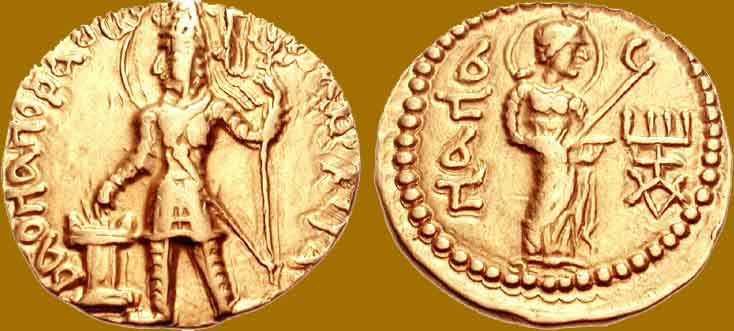
| Gold dinar, c. 195 CE
Weight: 7.84 gm., Diam: 21 mm., Die axis: 12 o'clock
Crowned, diademed king standing facing, nimbate, holding trident and sacrificing at altar at left,
Bactrian legend around: þAONANOþAO BA ... ZOΔηO KOþANO
(King of Kings Bazodeo Kushan) /
Goddess Nana standing right, nimbate, holding bowl and protome of animal,
Bactrian legend left: NANA, tamgha at right
Göbl 514 |
 |
One of the very few coins of Vasudeva featuring a deity other than Oesho. I suspect this may have been a coronation
issue. (Photo courtesy CNG.) |
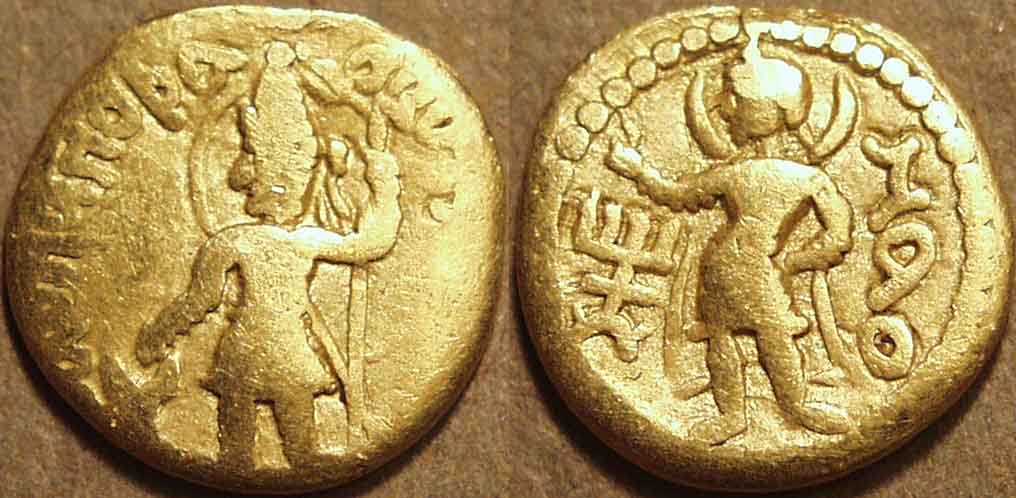
| Gold quarter dinar, c. 195 CE
Weight: 1.76 gm., Diam: 12 mm., Die axis: 12 o'clock
Crowned, diademed king standing facing, nimbate, holding trident and sacrificing at altar at left,
Bactrian legend around: þAONAONþAO ... BAZOΔηOþAO
(King of Kings Bazodeo King) /
Lunar deity Mao standing left, left hand on sword hilt, right hand held out hand in blessing,
lunar crescents on shoulders, Bactrian legend right: MAO, tamgha at left
Göbl 510A |
 |
One more coin type featuring a deity other than Oesho, the only other one recorded by Göbl. Note the shortened
obverse legend in light of the small flan ... the last word KOþANO has been replaced by þAO. Some other quarter dinars eliminate the last word entirely. Göbl
mistakenly grouped this coin type with other coins belonging to the later series with the additional trident above the fire altar. It clearly belongs with the early series that lacked
the additional trident. Note further that the tamgha on the reverse is not Vasudeva's but Huvishka's ... in fact the die used for this coin was an old Huvishka die; it had been used
to strike the Huvishka coin Göbl 277. Again, I suspect this coin was issued in Vasudeva's first year, never to appear again. The Mao reverse is known only in the quarter
dinar denomination, although it would be surprising if it had not been issued as a dinar also. |
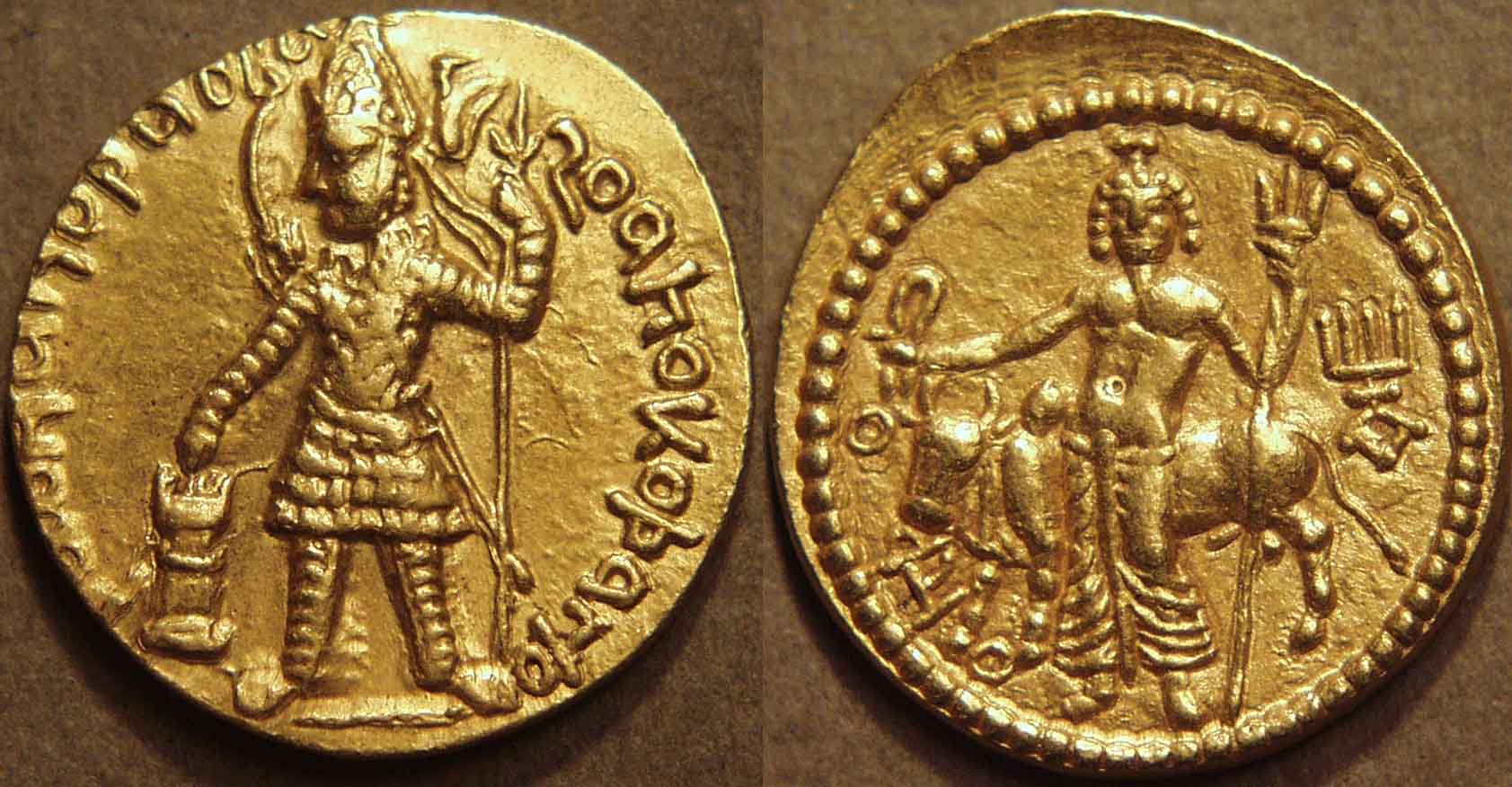
| Gold dinar, c. 195 CE
Weight: 8.07 gm., Diam: 21 mm., Die axis: 12 o'clock
Crowned, diademed king standing facing, nimbate, holding trident and sacrificing at altar at left,
Bactrian legend around: þAONANOþAO BA ... ZOΔηO KOþANO
(King of Kings Bazodeo Kushan) /
Two-armed Shiva standing facing, holding trident and diadem, Bull Nandi left behind,
Bactrian legend left: OηþO, tamgha at right
Göbl 504 |
 |
An example of the early Vasudeva issues in which there is nothing above the fire altar, and featuring Oesho on the
reverse. After this time, Vasudeva did not feature any deity other than Oesho on his coins. |
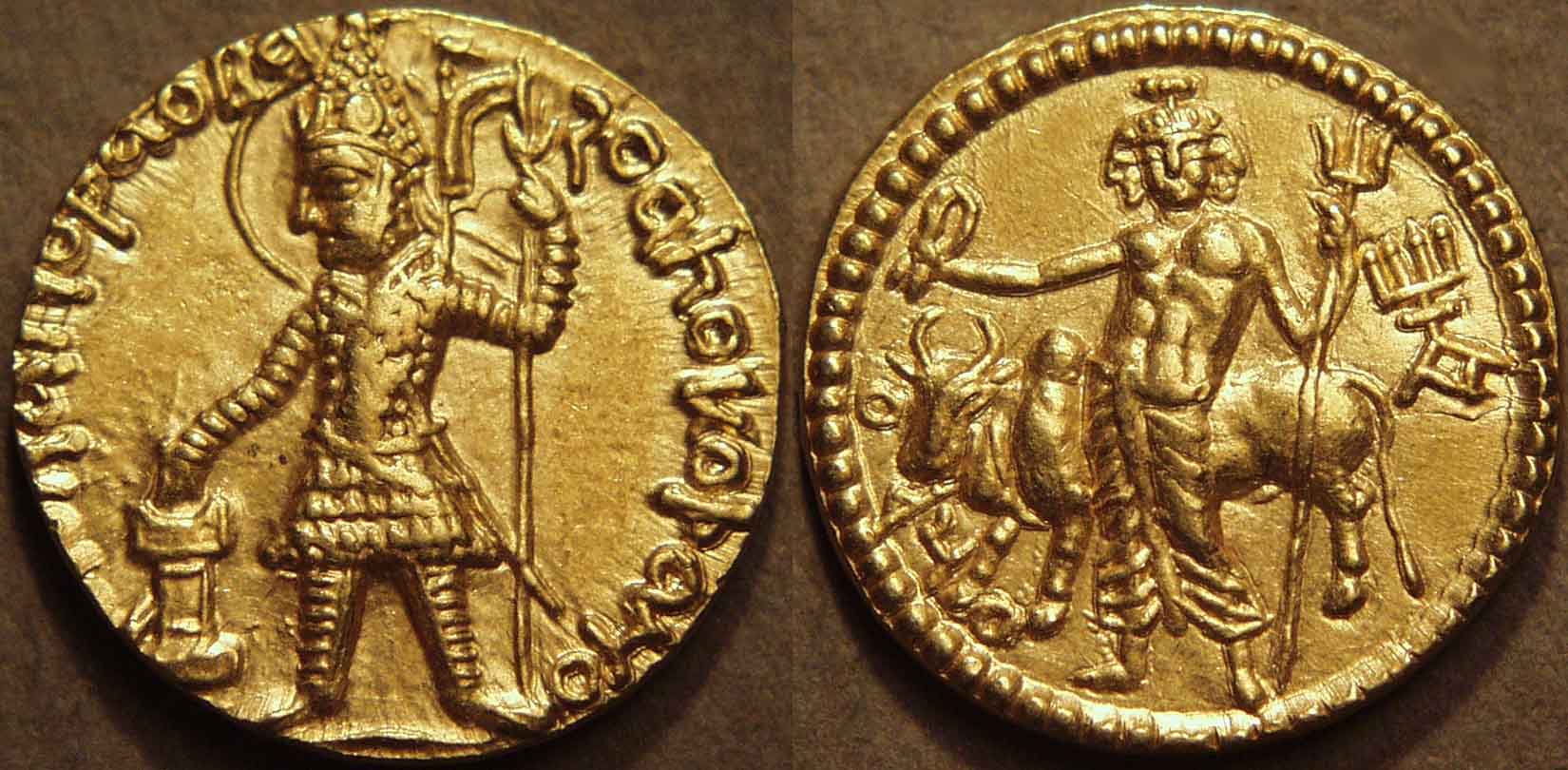
| Gold dinar, c. 195 CE
Weight: 8.06 gm., Diam: 20 mm., Die axis: 12 o'clock
Crowned, diademed king standing facing, nimbate, holding trident and sacrificing at altar at left,
Bactrian legend around: þAONANOþAO BA ... ZOΔηO KOþANO
(King of Kings Bazodeo Kushan) /
Two-armed Shiva standing facing, holding trident and diadem, Bull Nandi left behind,
Bactrian legend left: OηþO, tamgha at right
Göbl 504 |
 |
In this example, Oesho is shown with three faces ... an early version of the famous Trimurti sculpture of Elephanta
Island. |
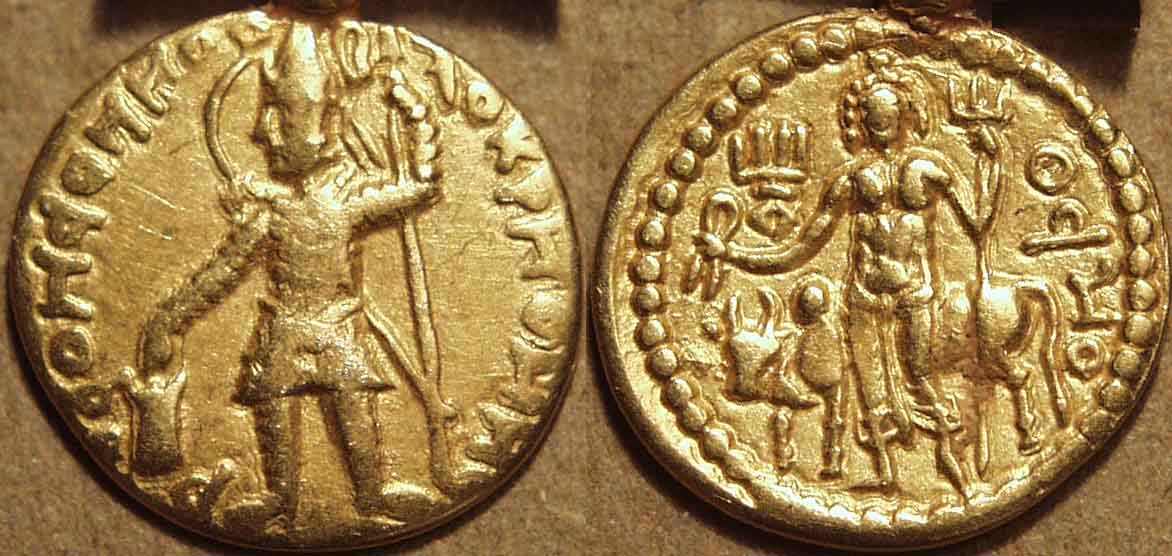
| Gold quarter dinar, c. 195 CE
Weight: 2.01 gm. (including loop), Diam: 14 mm., Die axis: 11 o'clock
Crowned, diademed king standing facing, nimbate, holding trident and sacrificing at altar at left,
Corrupt Bactrian legend around: þAONAONþAO ... BAZOKþHOHH /
Two-armed Shiva standing facing, holding trident and diadem, Bull Nandi left behind,
Bactrian legend right: OηþO, tamgha at left
Göbl --- (unlisted) |
 |
An unpublished variant of Göbl 505 ... this coin has Nandi behind Shiva, while G 505 does not. |
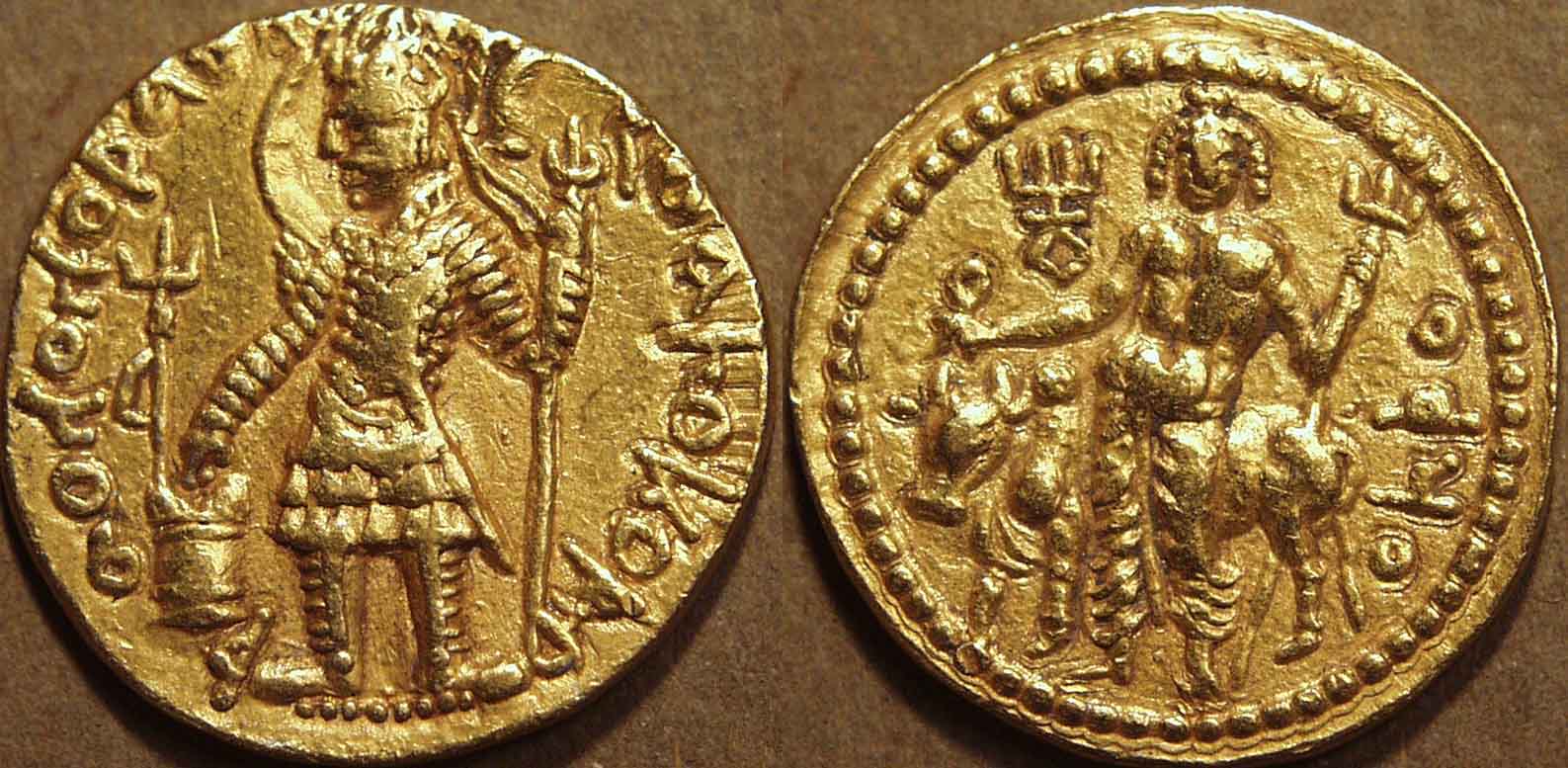
| Gold dinar, c. 200-225 CE
Weight: 7.80 gm., Diam: 21 mm., Die axis: 12 o'clock
Crowned, diademed king standing facing, nimbate, holding trident and sacrificing at altar at left,
second trident above fire altar, Bactrian legend around: þAONANOþAO BA .. ZOΔηO KOþN
(King of Kings Bazodeo Kushan) /
Two-armed Shiva standing facing, holding trident and diadem, Bull Nandi left behind,
Bactrian legend left: OηþO, tamgha at right
Göbl 504 |
 |
Note an unusual feature of this coin ... the celator
ran out of room as he carved the obverse legend, so he left out the vowels ... KOþANO became KOþN. |
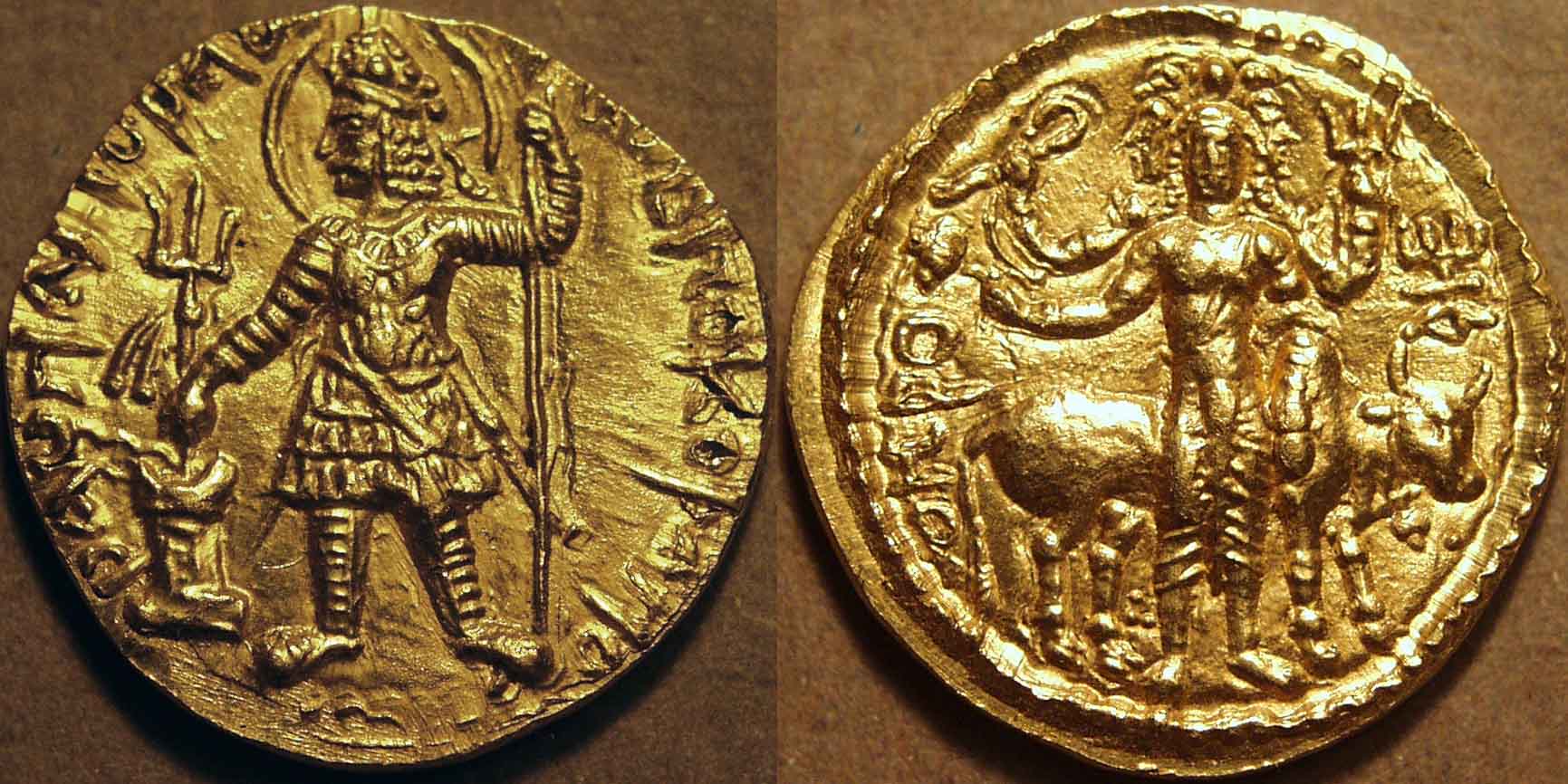
| Gold dinar, c. 200-225 CE
Weight: 8.02 gm., Diam: 21 mm., Die axis: 12 o'clock
Crowned, diademed king standing facing, nimbate, holding trident and sacrificing at altar at left,
second trident above fire altar, Bactrian legend around: þAONANOþAO BA .. ZOΔηO KOþANO
(King of Kings Bazodeo Kushan) /
Four-armed Shiva standing facing, holding trident and diadem, lotus and water pot, Bull Nandi right behind,
Bactrian legend left: OηþO, tamgha at right
Göbl 506 |
 |
This coin has a number of unusual features. Oesho here has four arms and three heads, and the bull faces right rather than
left. One of the objects in the deity's lower right hand is unusual for Shiva: a lotus. |
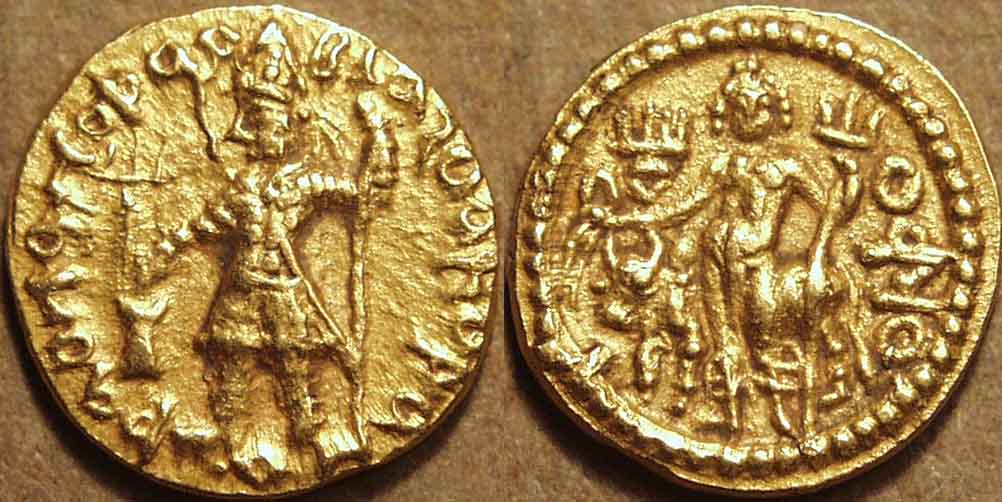
| Gold quarter dinar, c. 200-225 CE
Weight: 1.97 gm., Diam: 12 mm., Die axis: 12 o'clock
Crowned, diademed king standing facing, nimbate, holding trident and sacrificing at altar at left,
Bactrian legend around: þAONAONþAO ... BAZOΔηOþAO
(King of Kings Bazodeo King) /
Two-armed Shiva standing facing, holding trident and diadem, Bull Nandi left behind,
Bactrian legend right: OηþO, tamgha at left
Göbl 510 |
 |
The shortened legend is clearly visible on this coin. |
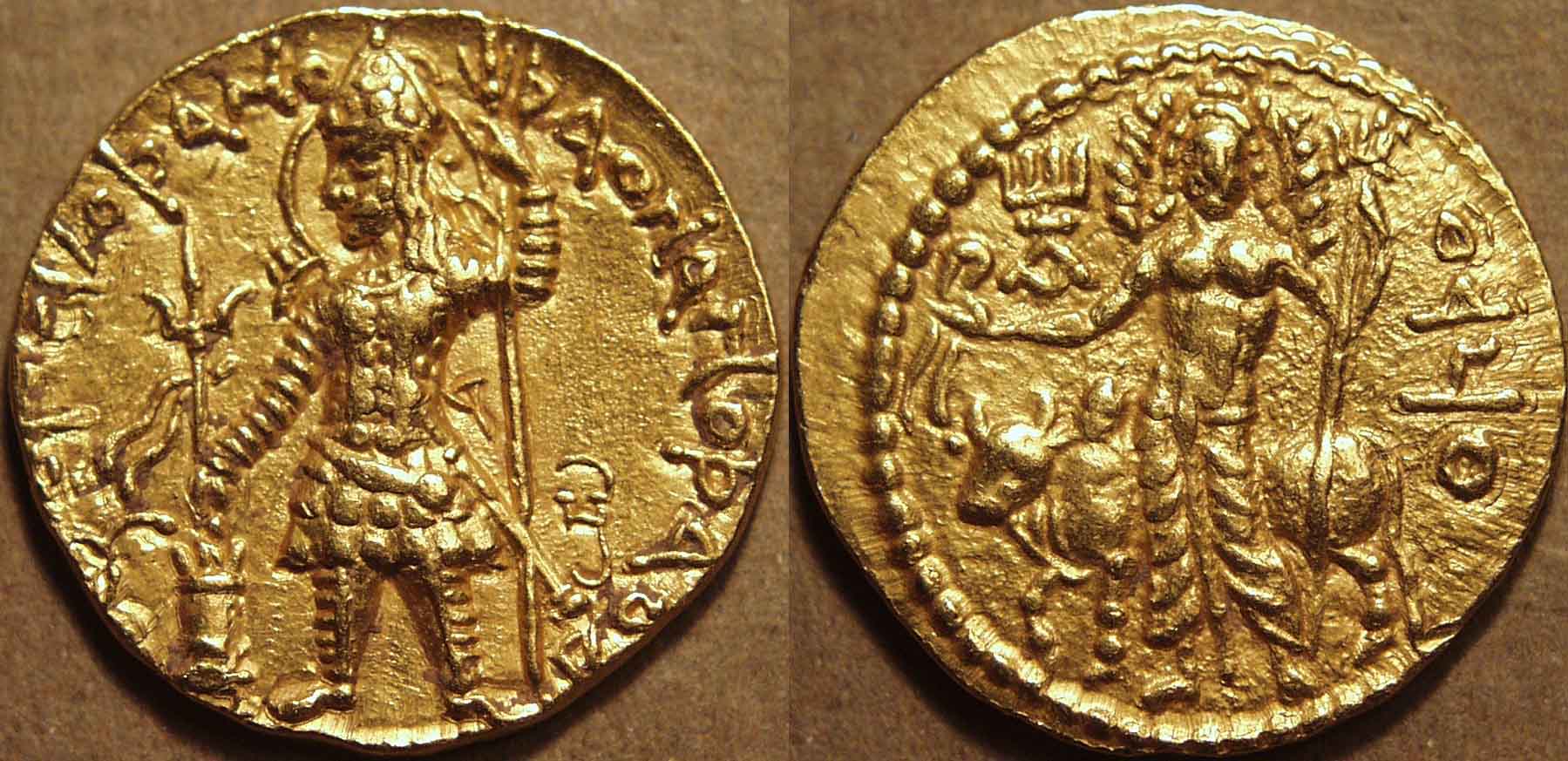
| Gold dinar, c. 200-225 CE
Weight: 8.04 gm., Diam: 21 mm., Die axis: 12 o'clock
Crowned, diademed king standing facing, nimbate, with long hair, holding trident and sacrificing at altar at left,
second trident above fire altar, Bactrian legend around: þAONANOþAO BA .. ZOΔηO KOþANO
(King of Kings Bazodeo Kushan), Brahmi pri in right field /
Two-armed Shiva standing facing, holding trident and diadem, Bull Nandi left behind,
Bactrian legend right: OηþO, tamgha at left
Göbl 533 |
 |
Later in his reign, Vasudeva started issuing coins with additional letters and symbols. Here he has added a Brahmi letter
pri in the right reverse field. This may have been a mintmark, but we don't know for sure. This coin also has the king with long hair, and the obverse legend starts at 1
o'clock rather than the usual 7 o'clock.
In his major study of Kushan coins Münzprägung des Kusanreiches, Göbl incorrectly assigned this and
subsequent issues of Vasudeva to a second king named Vasudeva ... Vasudeva II. However, in his later work, notably Donum Burns, the catalog of Kushan coins in
the Bern Museum (including notably the Burns Collection), Göbl acknowledged his error. However, this continues to cause much confusion among observers not familiar
with all the details. |
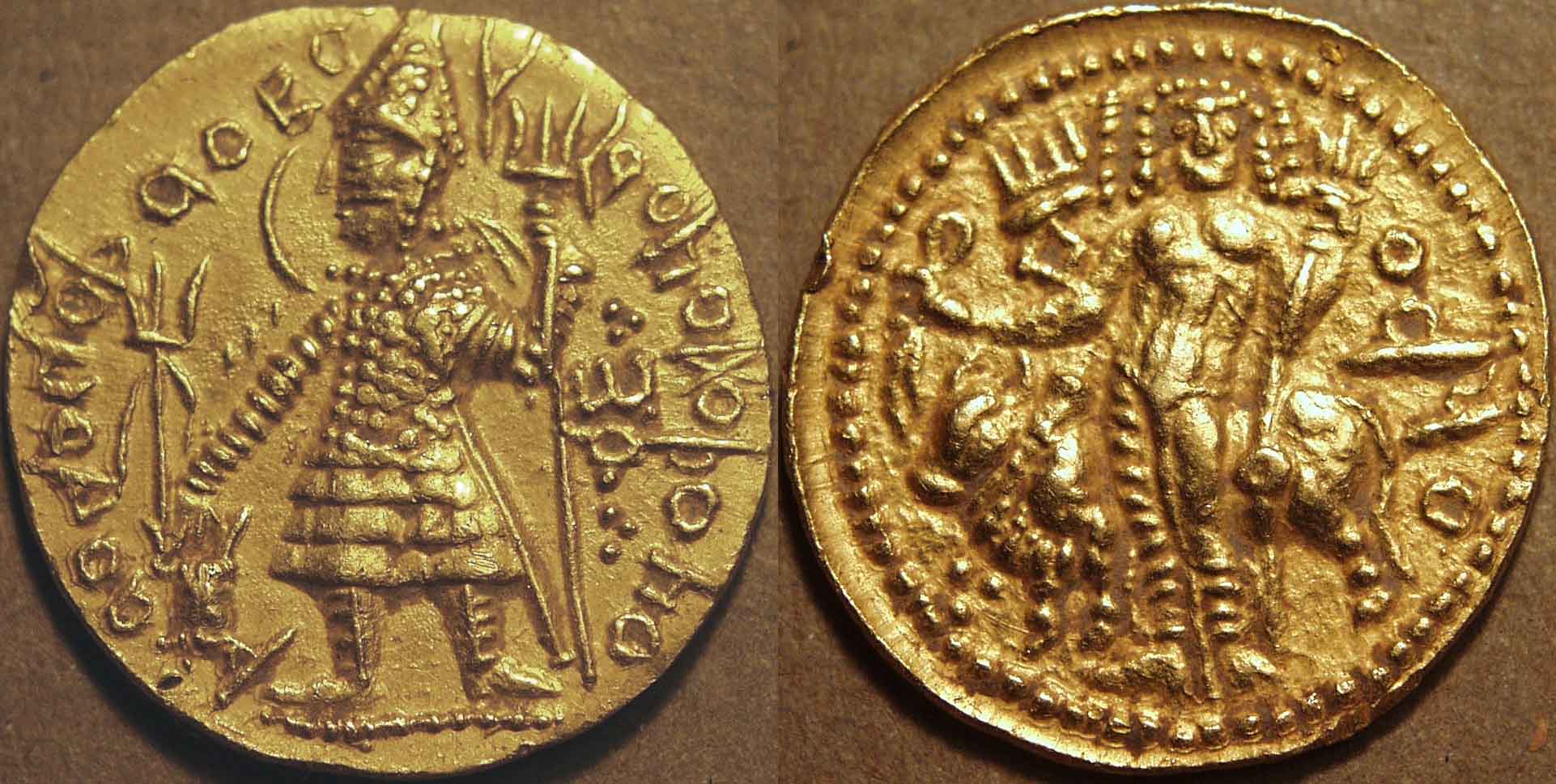
| Gold dinar, c. 200-225 CE
Weight: 7.97 gm., Diam: 23-24 mm., Die axis: 12 o'clock
Crowned, diademed king standing facing, nimbate, holding trident and sacrificing at altar at left,
second trident above fire altar, Bactrian legend around: þAONONOþAO BA .. ZΔOηO KOþONO
(King of Kings Bazodeo Kushan), nandipada in right field /
Two-armed Shiva standing facing, holding trident and diadem, Bull Nandi left behind,
Bactrian legend right: OηþO, tamgha at left
Göbl 657 var |
 |
As time wore on, Vasudeva's coins got cruder and more stylized, and the legend started to get blundered. One major
innovation, seen on this coin, was the introduction of a nandipada, the hoofprint of the bull Nandi, in the obverse right field. This was carried through on all subsequent
issues, including those that imitated the coins of Vasudeva issued by the newly emerging power ... the Kushanshahs or Kushano-Sasanians. |
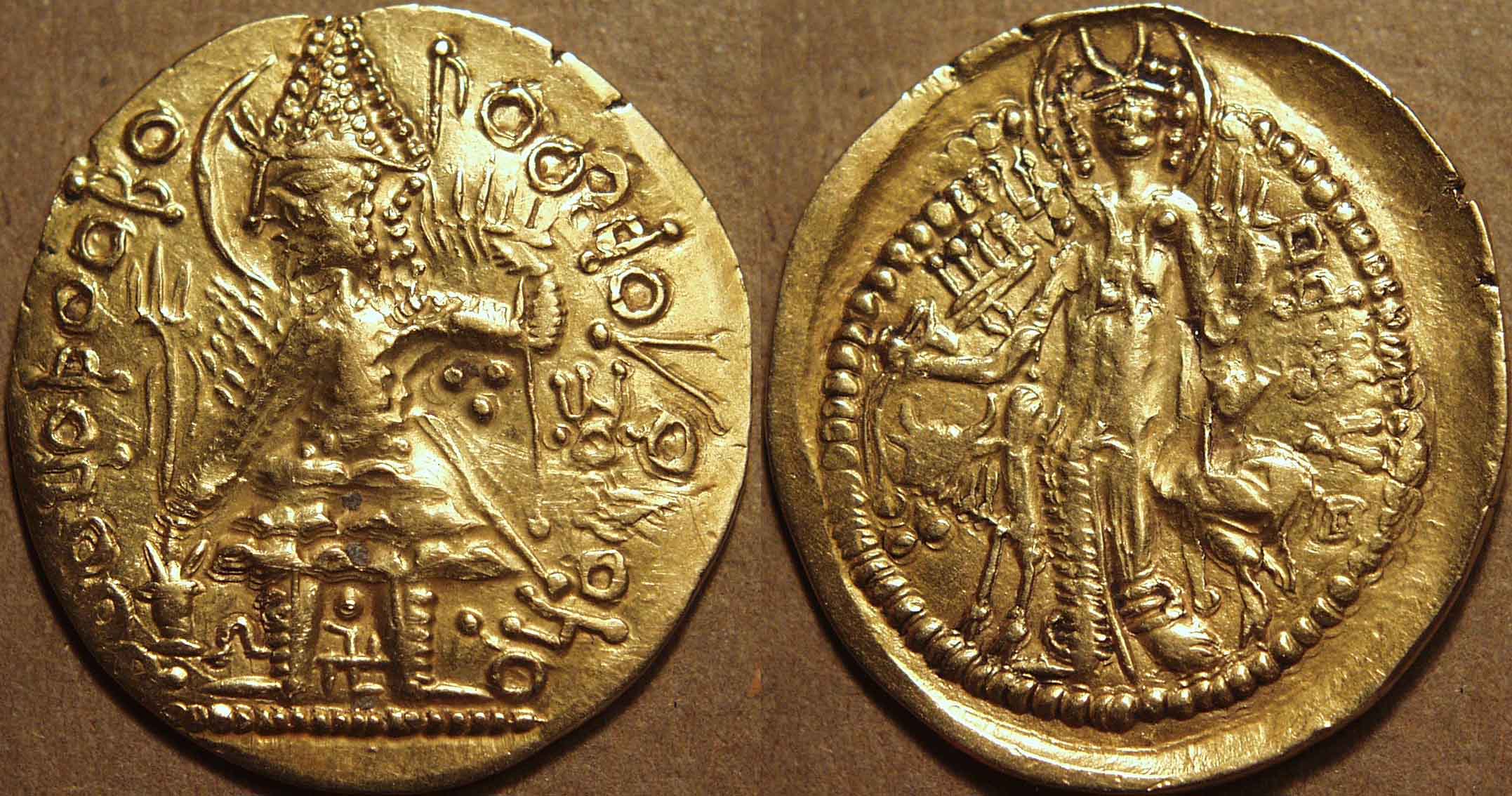
| Gold dinar, c. 200-225 CE
Weight: 8.06 gm., Diam: 26-28 mm., Die axis: 12 o'clock
Crowned, diademed king standing facing, nimbate, holding trident and sacrificing at altar at left,
second trident above fire altar, Bactrian legend around: þOONOþOO BO .. ZOOΔOηO KOþONO
(King of Kings Bazodeo Kushan), nandipada in right field, swastika between king's legs /
Two-armed Shiva standing facing, holding trident and diadem, Bull Nandi left behind,
Bactrian legend right: OηþO, tamgha at left
Göbl 688 var |
 |
One of the last of Vasudeva's issues, at least in the northwest. Here a swastika has appeared between the king's legs
and a crescent moon has for the first time decorated Shiva's forehead, an iconographical innovation that continues in representations of Shiva to this day. The coin has a
slightly scyphate shape, something we see in a very pronounced way in succeeding Kushano-Sasanian issues. This coin must have been issued shortly before Vasudeva lost
his northwest provinces to the Sasanian invader Ardashir ... Ardashir's first issues from this area look very similar to this type. |
 |
 |
 |
Copper coins |
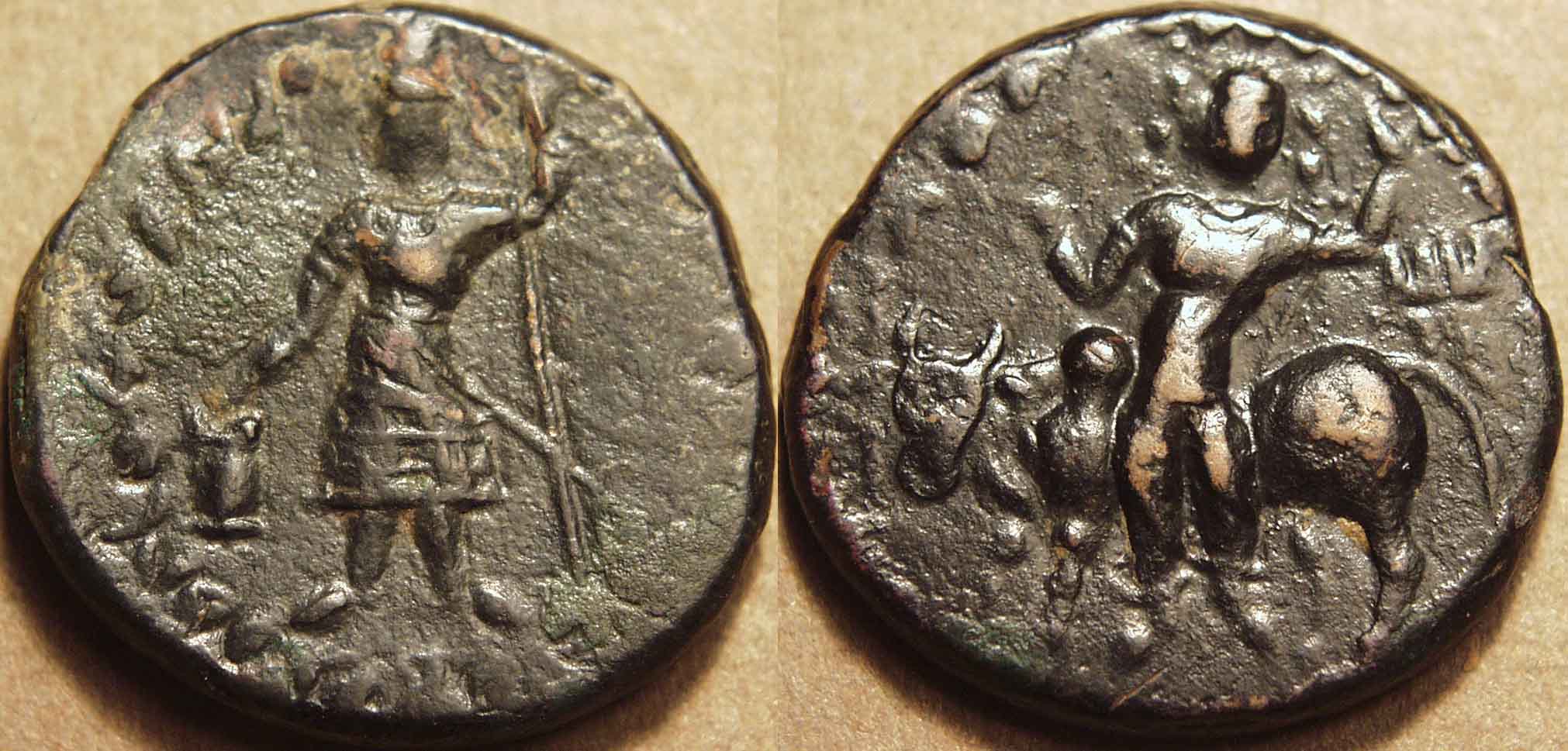
| Copper unit (tetradrachm?), c. 195 CE
Weight: 11.02 gm., Diam: 25 mm., Die axis: 12 o'clock
Crowned, diademed king standing facing, nimbate, holding trident and sacrificing at altar at left,
Bactrian legend around: þAONANOþAO BA ... ZOΔηO KOþANO
(King of Kings Bazodeo Kushan) /
Two-armed Shiva standing facing, holding trident and diadem, Bull Nandi left behind,
Bactrian legend left: OηþO, tamgha at right
Göbl 1000, MAC 3407-08 |
 |
The earliest copper coins match the early gold issues in which there is nothing above the fire altar. As far as we know,
Vasudeva did not ever feature any deity other than Oesho on his copper coins. Later coins feature the second trident above the altar. |
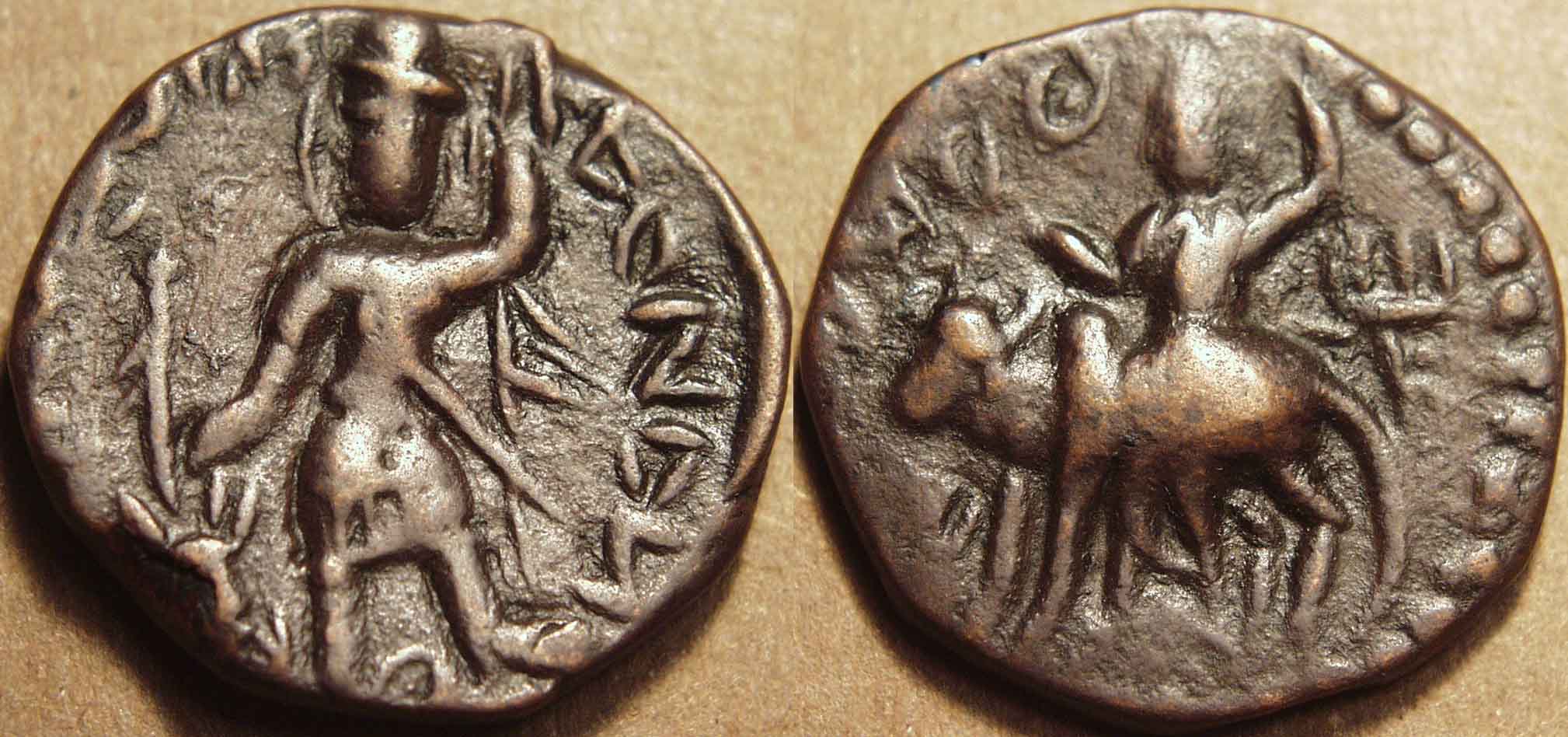
| Copper unit (tetradrachm?), c. 195-225 CE
Weight: 8.94 gm., Diam: 25 mm., Die axis: 11 o'clock
Crowned, diademed king standing facing, nimbate, holding trident and sacrificing at altar at left,
standard above altar, Bactrian legend around: þAONANOþAO BA ... ZOΔηO KOþANO
(King of Kings Bazodeo Kushan) /
Two-armed Shiva standing facing, holding trident and diadem, Bull Nandi left behind,
Bactrian legend left: OηþO, tamgha at right
Göbl ---, MAC 3412 var |
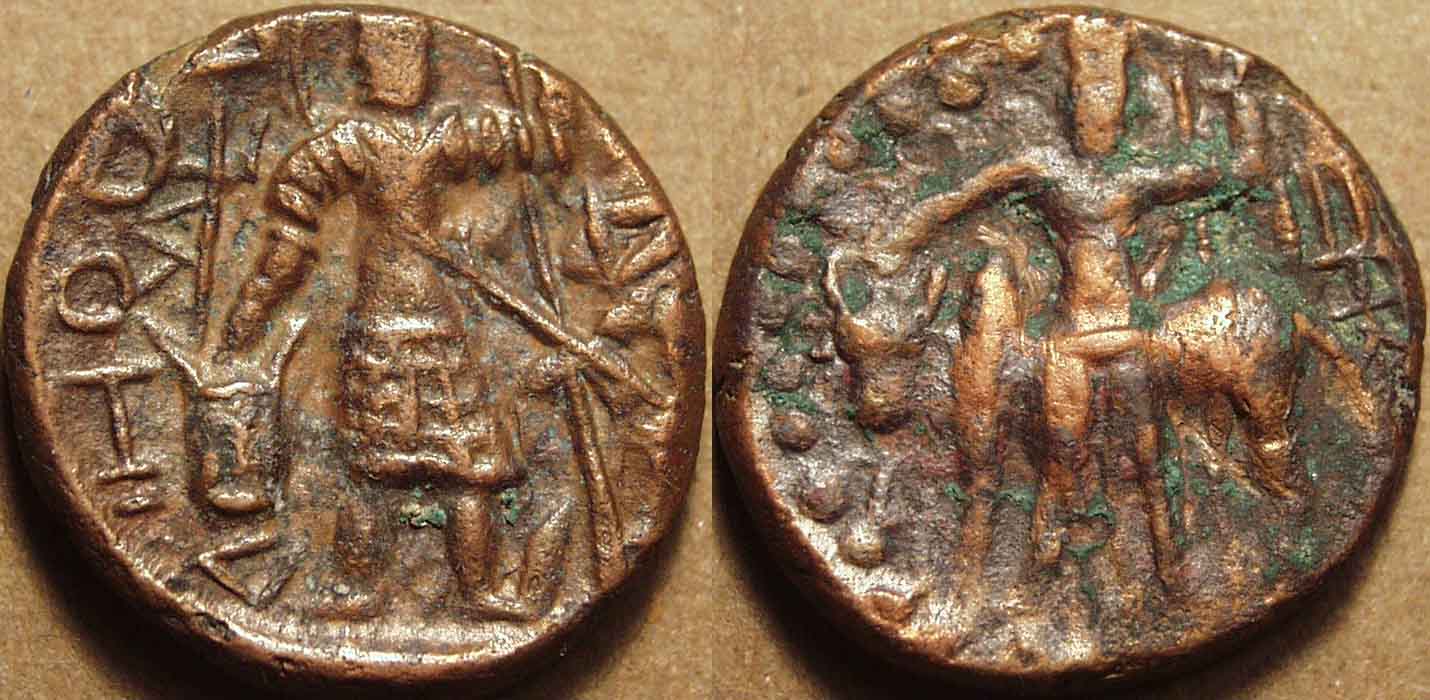
| Copper unit (tetradrachm?), c. 200-225 CE
Weight: 9.28 gm., Diam: 23 mm., Die axis: 11 o'clock
Crowned, diademed king standing facing, nimbate, holding trident and sacrificing at altar at left,
second trident above altar, Bactrian legend around: þAONANOþAO BA ... ZOΔηO KOþANO
(King of Kings Bazodeo Kushan) /
Two-armed Shiva standing facing, holding trident and diadem, Bull Nandi left behind,
Bactrian legend left: OηþO, tamgha at right
Göbl 1001, MAC 3413 |
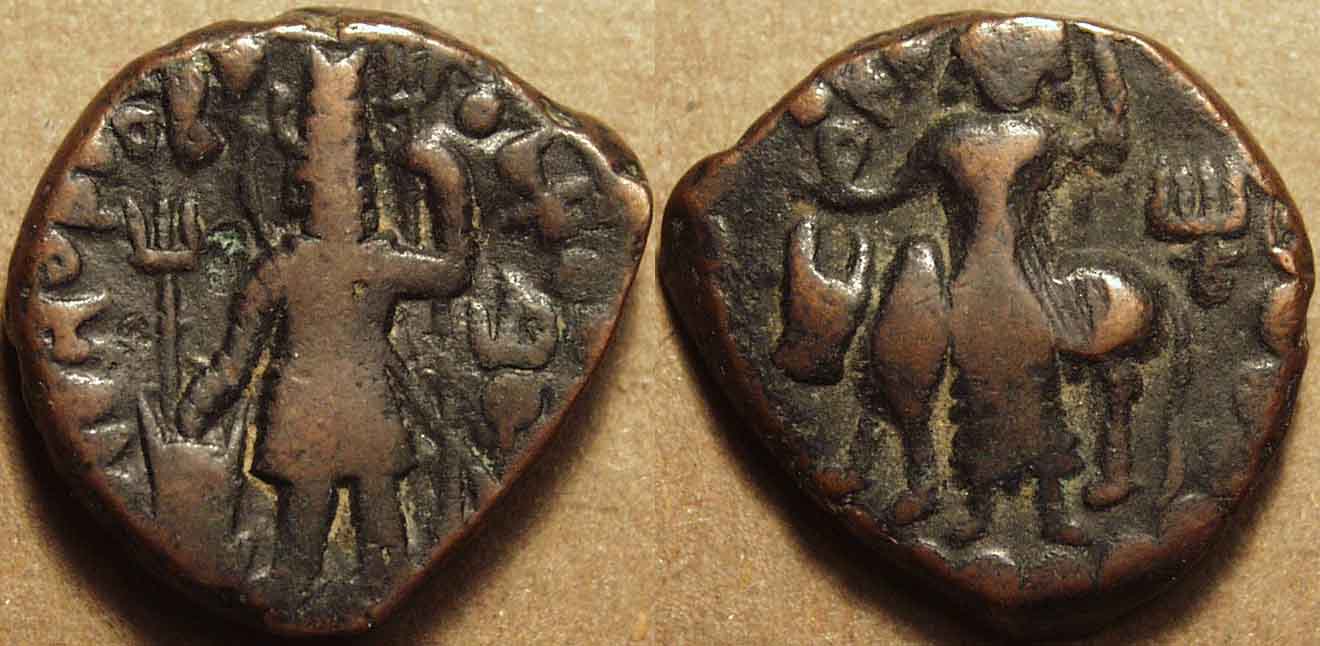
| Copper unit (tetradrachm?), c. 200-225 CE
Weight: 8.93 gm., Diam: 22 mm., Die axis: 1 o'clock
Crowned, diademed king standing facing, nimbate, holding trident and sacrificing at altar at left,
second trident above altar, Bactrian legend around: þAONANOþAO BA ... ZOΔηO KOþANO
(King of Kings Bazodeo Kushan), nandipada in right field /
Two-armed Shiva standing facing, holding trident and diadem, Bull Nandi left behind,
Bactrian legend left: OηþO, tamgha at right
Göbl 1004, MAC 3491 |
 |
This variety features the nandipada in the right obverse field. |
|
|